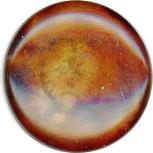|
VEGETABLE IVORY |
|
Vegetable ivory is made from the tagua nut. Originally the buttons were made primarily from nuts grown in Ecuador, but Columbia also supplied nuts. In the mid to late 1800’s, the V.I. buttons were being made in Europe and also in the United States. They were primarily used for shirts and trousers. The U.S. military used them as trouser buttons. Their peak encompassed nearly one hundred years, between 1860 and 1950. The V.I. button at right frames a celluloid center of a woman golfer . |

|
The tagua nut grows on a palm tree. It is a blooming tree. The blooms become a burr and the nuts are inside the burr. One burr of the smaller variety can weigh up to 20 pounds with several nuts inside. The nuts look like small potatoes. The trees can live up to one hundred years. The nuts are gathered year round; the harvest is very labor intensive. Some burrs will drop from the trees and can be picked up, but others must be cut and brought down. Nuts from South America have a very hard shell that cannot be cut. It takes a series of tumbling in drums, soaking, and drying before they can be cut and carved. Once the shell is removed from the nut, one can see that the nut is about two inches in diameter making it difficult to get a large button. This is why Division I large buttons are scarce. The engraved and dyed black button at left tells the story of Little Black Sambo outwitting the tigers. The story was written in 1889, during the high point of V.I. manufacturing. At right is a large V.I. button embellished with green glass bordered with brass. |


|
In collecting V.I. buttons, one can look for back marks, shanks, OME, dyed, with bark, pictorials, pressed designs, set in metal, and painted. Many of the pressed pictorials that I have found are small. One can also find V.I. with a stencil design. The stencils include a spider web, owl, cat, and several dogs. There is also a door knocker, shown below, that is moveable. |

|
At right are two carved Division I realistic buttons, both rare: a dog and a basket of roses. Another nice Division I button has a pin shank back type with metal embellishment, above. |



|
Other V.I. rarities are this pearlized example, left, and the thread back, right.
|




|
From left to right below: the pad back V.I. is a little easier to find in both medium and small size. Even Division I usage buttons can be found, like this “I Crow Over All”. The hunt may even discover a back mark, such as this button marked “F.A. Wish * 1924©”.1 V.I. buttons were also used by the military.2 |


|
The V.I. button at left is a carved background with a brass Mayan escutcheon in the center. The vegetable ivory button is often dyed. That is why the button can often be determined to be V.I. by looking at the shank. If it has been drilled, one will be able to see the original whiteness of the nut. They were often confused with ivory if left undyed. How they are dried can also produce many colors. |

|
At right are two examples of vegetable ivory buttons with stencils. If you look closely, you can see the dog. The other is a spider web. The spider web is a whistle. |


|
Things are different now. There are about a dozen species of these nut-bearing trees. One that grows on Pohnpei Island in the Pacific produces nuts that are from four to six inches in diameter. This is the only Island where this tree grows. In the past, it was rare to see a large V.I. button, but some very large buttons are now being produced.
Currently, there are some very nice studio buttons made by painting slices of V.I. There are also some imported from Bali, for instance, that are not considered studio even though they are hand carved. That is because the carvers do ten buttons at a time, so the process is considered manufactured. The carvers are Hindu and are not allowed to sign their work because the Hindu religion does not allow notoriety of oneself. |